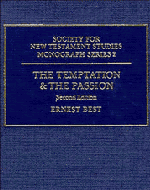Book contents
- Frontmatter
- Contents
- Preface to the First Edition
- Preface to the Second Edition
- List of Abbreviations
- PART I THE TEMPTATION
- PART II THE PASSION
- III The Markan Seams
- IV The Selection of the Material
- V The Order of the Material
- VI The Witness of Jesus and Others to Himself
- VII The Titles of Jesus
- VIII The Christian Community
- IX Conclusion
- Bibliography
- Index of Authors
- Index of Subjects
- Index of Passages Quoted
- Index of Greek Words
IV - The Selection of the Material
from PART II - THE PASSION
Published online by Cambridge University Press: 28 October 2009
- Frontmatter
- Contents
- Preface to the First Edition
- Preface to the Second Edition
- List of Abbreviations
- PART I THE TEMPTATION
- PART II THE PASSION
- III The Markan Seams
- IV The Selection of the Material
- V The Order of the Material
- VI The Witness of Jesus and Others to Himself
- VII The Titles of Jesus
- VIII The Christian Community
- IX Conclusion
- Bibliography
- Index of Authors
- Index of Subjects
- Index of Passages Quoted
- Index of Greek Words
Summary
When we ask why Mark has chosen the particular pericopae which we find in this Gospel we meet an initial difficulty: we do not know what material was available to him out of which he could select. If we knew that Mark had a great amount of material about the teaching of Jesus, say a ‘copy’ of Q and only three exorcism accounts, and chose to omit most of the teaching and put in all three exorcisms, this would obviously lead us to conclude that for him exorcisms were most important. Equally had he at his disposal only the teaching of Jesus which he has inserted and a hundred exorcism stories from which he selected the present three then we would come to quite a different conclusion about the importance of the exorcisms for Mark. Unfortunately we are not in a position to draw either conclusion. We may note that most of the expansion of Matthew and Luke is in the direction of giving fuller teaching by Jesus; in proportion there are not added as many new pronouncement stories and miracles as direct teaching. This would suggest that Mark used most of the available material about the activities of Jesus, other than about his teaching. We must not therefore assume that Mark had unlimited material at his disposal (cf. John xxi. 25) from which he made a judicious or injudicious selection. The early Church may already have trimmed down the amount of available material and left Mark with little from which to select.
- Type
- Chapter
- Information
- The Temptation and the PassionThe Markan Soteriology, pp. 103 - 111Publisher: Cambridge University PressPrint publication year: 1990



